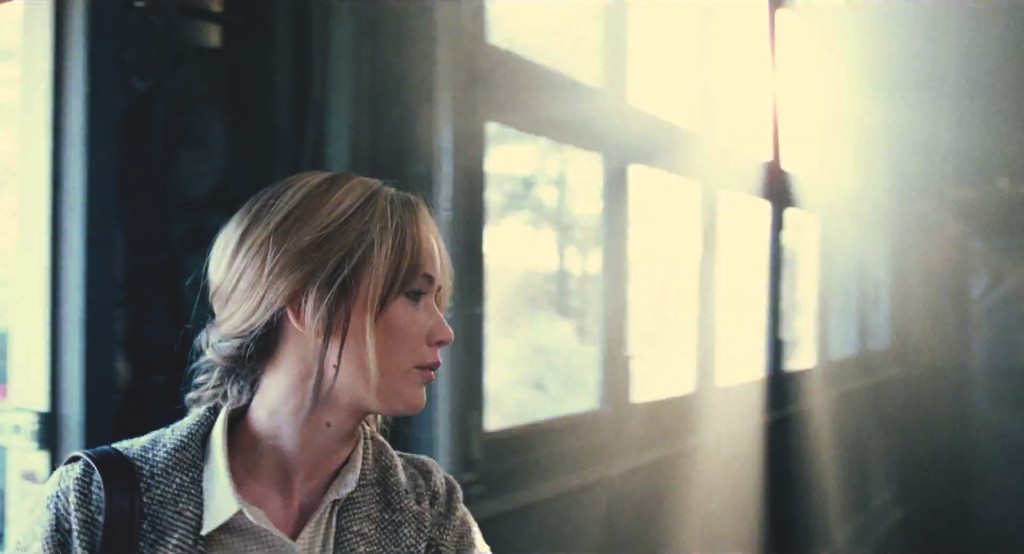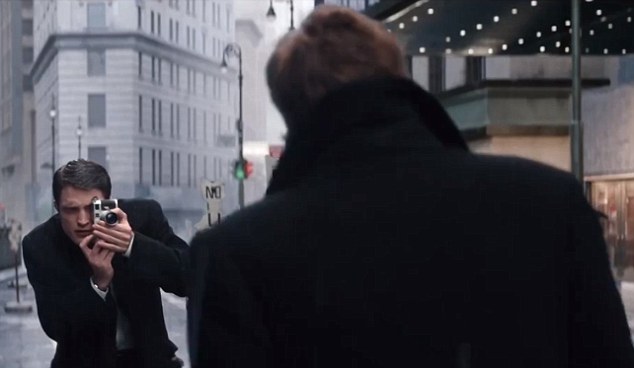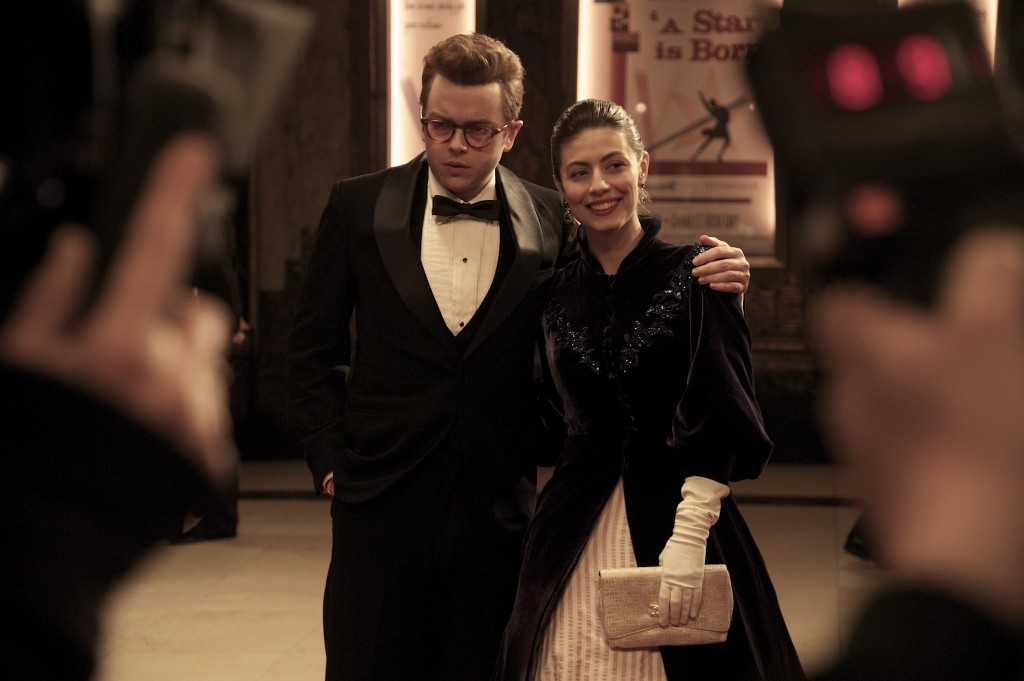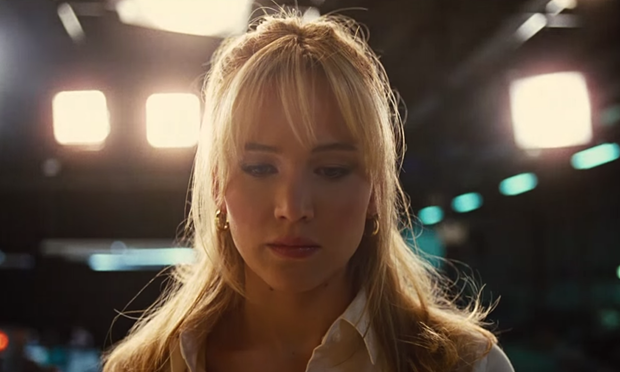Alex writes about Joy, Carol, self-image, and Jennifer Lawrence (again).
How you project yourself to the world is something you think about constantly, whether you want to or not. You fix your hair, you choose your clothes for the day, you decide to put on less-than-utilitarian footwear. Even idiots like me – who have had the same excessively simple haircut for decades, wear virtually the same outfit everyday, and wear sneakers regardless of the weather – do this. My sneaker allegiance is built around the simple conceit that I don’t want to be a “boots person,” whatever that means. Dressing to avoid standing out in any way is still a stylistic choice. (Tom McCarthy got nominated for an Oscar for his directorial version of my daily attire.)
Our image is something we have to think about all the time because – assuming you live in a city – people look at you all the time, even if only for a fleeting glance. If people are merely looking for an instant, enough of these instances will still make you care. This is why I don’t wear sweatpants outside of the house.
You want people to look at you in a certain way. We all do, whether we’re willing to admit it or not.
Carol is a romance between two women at a time when such things were not allowed, but – like all of director Todd Haynes’ best work – there is a strong theme of personal image projected throughout. As the film progresses, the most interesting questions become about something other than the romance at the centre of the film. How does Carol see herself? How does Therese see herself? Most importantly, how does Therese see Carol through the lens of her camera? What is the image captured?
Anytime one makes a movie, they are inherently commenting on image in some capacity, because filmmaking is an image-based medium. When Anomalisa was staged as an audio play in 2005, it was done specifically to augment the facelessness of the script. As it became a film in 2015, the stop-motion animation techniques used were chosen specifically as a way to comment on humanity. Everybody looked and sounded the same, because that is how Michael Stone views the world outside of his own mind. That co-directors Duke Johnson and Charlie Kaufman chose to not remove the spaces between the various pieces in the puppets further augments the way we see ourselves: as people constantly on the verge of falling apart. In Anomalisa, you can see the cracks in the façade, and everybody has them.
Todd Haynes understands this relationship between film and personal image perfectly, and seemingly all of his movies are about the way image is projected in some way. His previous film, the borderline masterpiece I’m Not There, was about your own ever-changing image of yourself more than it was ever about the life of Bob Dylan. (I suspect that I will be able to watch this film every decade for the rest of my life and have a distinct, equally positive takeaway each time. There are almost no other films I feel this way about.)
In Carol, we see a similar image-based thread running beneath the plot of Carol and Therese’s forbidden appreciation of each other. Therese is a closed-off, quiet person, and she is also a photographer. Naturally, we are meant to believe she projects herself through her art, because this is what we have been taught through decades of cinematic language. As Carol progresses, we see Therese stop taking photos of inanimate objects in order to embrace human subjects, starting with Carol as she falls more in love with Kyle Chandler’s wife. Therese sees somebody, she wants to be with somebody, and then eventually she starts looking at that somebody differently, and in a more confident light. The way she looks at Carol changes the way she looks at everything, and then she opens the shutter and prints that look onto a frame of 35mm film.
In Anton Corbijn’s little-seen 2015 film Life, Corbijn shows photographer Dennis Stock’s journey to try to get an about-to-be-known James Dean to agree to a naturalistic photo shoot, one away from the glitz and glamour of Hollywood. The idea behind Stock’s proposed photo essay is that Dean is going to have a public image soon enough, and it is going to be constructed whether he likes it or not. Stock merely feels that his ideas for that image are better for Jimmy than those of the gorillas in the paparazzi pit at the East of Eden premiere. Stock wants Dean to stand out from the fray, because he believes Dean is a standout in waiting.
Now, I occasionally get to view those red carpet gorillas, and I can tell you nothing is faker than the whole process. I’ve seen it occasionally for approximately five years now, and literally the only interesting thing that has ever happened in a photo pit was Kristen Stewart angrily telling the photographers that she can’t follow all of their demands at once. Corbijn is a photographer himself, and I trust he has seen his fair share of such horror shows as well. These pits exist to have photographic proof that, yes, the stars were here and, yes, they sure looked gorgeous and, yes, we all had a grand old time in this perfect world. But the reality is that these images mean nothing, because your true image exists outside of it.
Nobody gets boiled down to a single image anymore, because today images are so much easier to capture than in the past. Sam Shaw’s iconic photograph of Marilyn Monroe can’t exist anymore, because if Monroe had been a celebrity today her image would have been even more ubiquitous than it already was. There would be no single, iconic image, because there would be too many images to have one lock into our collective cultural mind.
If you try to think of a single image of Kim Kardashian right now, you are likely thinking of the Break the Internet cover of Paper Magazine. But there’s also a pretty good chance you’re thinking of something entirely different; maybe a still from the Bound II music video, or a paparazzi shot of her carrying North somewhere. Even in a shared culture, your exposure to Kardashian is likely different from mine, because we have so many ways to be exposed. Nobody, not even the most controlling of stars, gets to be seen how they truly want to be seen. The totality of humanity is always collectively more creative than any team of publicists can be, even those working for Jennifer Lawrence.

David O. Russell’s latest film Joy is a messy affair, like all second-phase Russell work, but its highs are more than worth waiting for. (Not unlike – hopefully, at least – this paragraph. Prepare yourself emotionally for some boring exposition, beginning just past the parentheses.) As Joy Mangano invents a mop head that can be wrung out and thrown into a washing machine to be easily cleaned, she tries to come up with a way to sell it, eventually finding her way into the new world of shopping television. Bradley Cooper’s character Neil is sold on her idea and gives it to one of his finest salesmen, Todd, to sell on the air. When the time comes for Todd to shine, he fails miserably and Joy’s hopes and dreams, as well as her finances, are crushed.
But Joy is not the type of person to let somebody else tell her what to do. She charges into a meeting with Neil and demands he let her get on television and sell it her way. The mop comes from her life experiences as a single mother, and she put everything she learned cleaning up after her kids into this, so she deserves the opportunity to sell it herself. Neil relents and – finally – the exposition ends, so the exhibition can begin.
As Joy gets ready to go on-camera, the film drives home how removed from this world she is: Joy refuses to wear the dress Neil gives her, and is taken aback when the spinning set slowly puts her in front of the necessarily bright lights of television. She is stopped in her tracks, stammering and sounding unconfident, until Neil cues a call from Joy’s friend. This lifeline to reality brings Joy back, and allows her to connect the fake world with her reality, and to sell a shitload of mops.
The most interesting element of this portion of the movie is how it seems to comment on Jennifer Lawrence’s own ascension to fame. As Neil, an obvious extension for David O. Russell, explains as he parades Joy around the QVC studio, “David Selznick, who was the son of immigrants, married Jennifer Jones from Oklahoma, who was America’s sweetheart. That just goes to show you, in America, the ordinary meets the extraordinary every single day.”
This is what we have been told Jennifer Lawrence is: an ordinary person who exists in an extraordinary world. She is Jennifer Jones from Kentucky, born anew in District 12. She’ll find her son of immigrants soon enough, and complete the American dream of extraordinary normalcy.
When Joy informs Todd how he should sell the mop, Todd responds by saying such tips aren’t helpful. “That’s not my process,” he says, and Joy looks surprised, further implying that Lawrence might be an actress too, but she has no ‘process.’ She’s too normal for that. Russell just turns the lights on and Lawrence comes out there to play pretend. There’s nothing more to it than that, even though there obviously is.
My favourite shot of Joy occurs as Lawrence is being spun around to sell the mop for the first time. She is being introduced to America, and the ever-flaring lights she must stare into are bright. When she gives into them, she is stilted, her performance unreal, but by ignoring them upon hearing the voice of her friend, she is able to take control and win America over by way of charming mop head sales. Joy ignores the set up and makes herself look like one of us, and we all fucking love her for it.
This is what Jennifer Lawrence does all the time. When she was nominated for an Oscar for Joy this month, she said she didn’t realize it had happened because she was too busy working. This is obviously bullshit. She knew immediately, probably even expected it, and she jumped up and down just like a first time nominee would. She might as well be the co-head of Taylor Swift’s squad of fakery.
Admittedly though, some of her dalliances into lightly staged realism charm even me: when Lawrence tells a reporter to stop looking at their phone, I love it, as I too wish people would stop looking at their phones so much, and I too love it when people are mean to certain types of media members. But Lawrence’s game is a hit or miss venture. For every phone-shaming incident, there are nine instances of Lawrence talking about how she loves gorging on Cheetos, or that she hates reading, or says pretty much whatever she can to seem like the majority. It’s pandering in the worst way; pandering that blends in well enough that people are willing to ignore it.
This is how Jennifer Lawrence wants to be seen: as somebody just like you. In a modern culture where we all value our own import more than ever before, she is the one that reminds us the most of ourselves. She is important, because she is me. We root for her, because we want to be successful, and if we can’t, at least we’ve got Jenny from Kentucky up there selling us romance, heroism, and mop heads.
At one point when I was writing this, I was convinced this essay was going to be short. Go back and look at the initial paragraph about Carol: that is the pointed message of a man on a mission. And it worked for a bit. I was happy with a short version of this piece, one I could have let exist in the internet for all to potentially read but none in reality. But then I couldn’t do that. I couldn’t let this representation of myself exist in the wild, even if there are no content hunters looking for it. For some reason, I care what other people think, knowing full well nobody is watching.
It is human nature to care about how you’re perceived. Regardless of how you care, we all do somehow. I didn’t want to just be a person that wrote yet another barely-college-level film essay, so I gussied it up with Voice, as modern wannabe writers are wont to do. This impulse to cloud one’s ideas might be bad in the long run – almost certainly is bad in the long run – but it cannot be denied that it is an impulse that exists.
Life ends before Dean dies, but the photos depicted in the film both created Dean’s image and exist outside of it. The still I think of when I think of Dean is a piece of Stock’s work, but Dean’s defining image was created when he crashed his car. He literally lost control, and lost the control of his image with it. He didn’t get to be the good ol’ boy from Indiana anymore; he had to become the rebel without a cause, a guy that drove too fast for no definable reason. It’s how we saw it, so that’s how it was.
I have no idea how Lawrence’s career will shake out, but I am certain that her image will not settle exactly how she wants it to. Her routine will become trying, and we will turn. We always do. If anything, the resigned cultural acceptance of Joy signals that this turn is beginning. And when we do change our minds on somebody, the one thing we stop doing is what the person in question wants us to. Try as you might, your image will create itself, and it will differ depending on how somebody is looking at you at any given moment.
When a director – a star, a studio, whoever – releases a film, they are always playing a game of chance. Film is inherently an image-based medium, and producing a film is an inherent gamble. You are spending millions of dollars on something that is more likely to lose money than make any. Nobody can really know how the public will react to your film as it’s being made, because of all of the ancillary elements that are involved. Marketing has yet to be decided, release strategies undetermined, whether you’ll be interviewed on Jimmy Kimmel’s couch or at Charlie Rose’s round table. Sometimes there will be a hit nobody saw coming, or a bomb nobody anticipated.
I am being foolish right now, in the name of something nobody but me cares about. I am lying awake at 4am, drinking bourbon and trying to fall asleep, because I have to work in the morning. I should close my laptop and attempt to slumber, but I won’t, because I can’t. I have to make this thing that nobody will read an accurate representation of how I view myself. It doesn’t matter if anybody is looking, I will still know how it looks. This impulse seems problematic. Or maybe none of what I’m saying is true, and I’m merely throwing things at the wall to see what sticks, knowing full well J-Law has already created a mop that will help me clean up my own mess.
You can never really control the reception of anything. It doesn’t matter how hard you work to be seen a certain way, people are going to see you through their own lens.
You are who you are, but what really matters is who they see.








